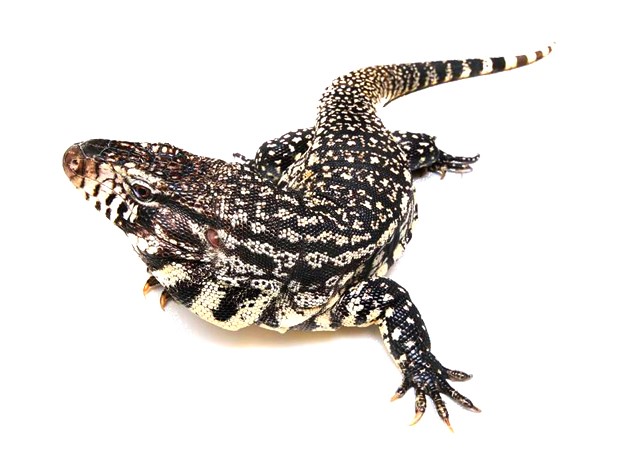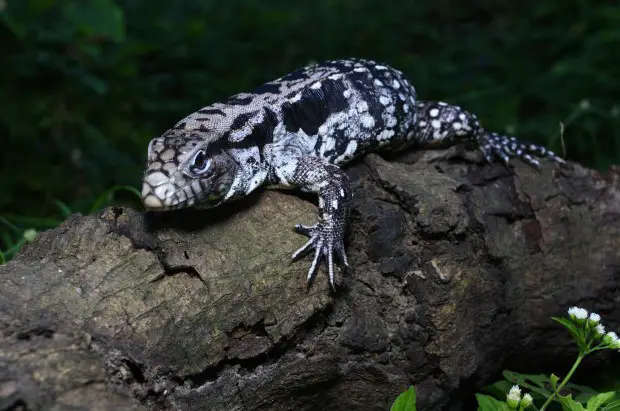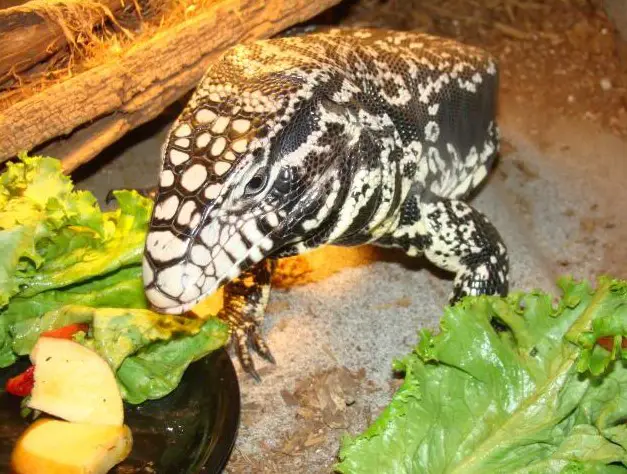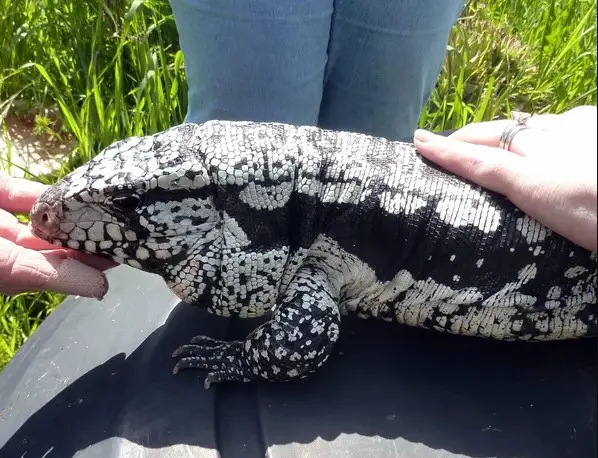Argentine Black and White Tegu (Tupinambis merianae) is a very interesting and beautiful lizard that lives in the jungles of Argentina, Brazil, and Uruguay.
Appearance
Tegu is large lizards with a body length of more than a meter. In natural conditions, there are even two-meter individuals! Males are larger and more powerful than females. Adult Tegu weigh 7-8 kg. The body of the lizard is flattened, short and strong legs are well adapted for digging, short and strong (by the way, they love to dig). By the name of the animal, it is easy to guess that its color is black and white – alternating transverse stripes run all over the body.
Of course, not everyone has the opportunity to keep a one and a half meter dinosaur in their home, and not everyone will dare to do this. But if you have both the desire and the opportunities, you will get a wonderful – rare and unusual pet, which, with good care and caring attitude, can live next to you for more than 15 years.
Keeping
To keep the Argentine Tegu, first of all, you will need a large and very durable terrarium. The minimum size of a dwelling for one adult reptile is 250x90x90 cm, and for a pair of animals – 250x120x120 cm. Needless to say, the larger the terrarium, the more comfortable your pets will be. The top of the terrarium should be closed with a net – Tegu easily overcomes all obstacles.
The humidity in the terrarium should be kept at 60-70%. The bottom of the terrarium should be covered with a deep layer of substrate. A mix of soil and sawdust is suitable as such – such a material retains moisture well. Once or twice a day, the litter should be sprayed with warm water, but without creating a “swamp”, but so that it is slightly damp.
Several large driftwood and stones can serve as decor. Both live and artificial plants will not work – they will simply be immediately destroyed by the reptile. If the substrate is deep enough for your pet to burrow in it, you won’t need shelter. Otherwise, shelter should be taken care of. The feeder and drinker must be made of durable material and must not tip over.
For a baby, Tegu needs to provide a substrate depth of 7-10 cm, a teenager will need 20-25 cm, and for an adult animal, the bedding layer can be up to 50 cm.
For Tegu, it is necessary to provide a temperature difference in the terrarium. The warm part of the terrarium should be around 30 ° C, and the cold 24-25 ° C. Remember that this is the surface temperature, not the air temperature, so you need an infrared thermometer. The night temperature should stay around 24 ° C and never drop below 18 ° C – otherwise, the heat-loving reptile may catch a cold. The best solution would be to install several lamps of low power – it is easier to achieve the specified temperatures.
To provide the animal with the UV light it needs, it is recommended to use a large UV 10.0 tube lamp. An alternative is to use a mercury UV lamp instead of one of the heating lamps.
All lighting and heating lamps should be on 12-14 hours a day, and the terrarium should be plunged into darkness for 10-12 hours.
Tegu loves to soak in the water – to bathe your pet will need a pool large enough to fit the entire lizard. The pool water should always be fresh.
Feeding
Your pet is primarily a carnivore. Under natural conditions, these predators eat any live food that comes along and with which they are able to deal, but they will certainly diversify their diet with fruits.
Diet of an adult lizard
In captivity, the diet of an adult lizard should consist of a third of insects (locusts, crickets, mealworms, forage cockroaches) and earthworms, a third of all types of meat (chicken breasts, beef liver, and heart, etc.), and a third of plant food (Tegu love tomatoes, grapes, pineapple, mushrooms, cabbage, peas, melons, mangoes, apples, strawberries). Don’t give Tegu citrus!
From time to time, the lizard can be pampered with rodents. One serving for an adult Tegu is a full dinner plate. When feeding adult lizards, one fasting day is arranged every three days.
It is recommended to feed Tegu according to the following scheme: 1-day insects or worms, 1-day fruits or vegetables, 1-day meat, and 1 day – hungry.
How to feed juveniles?
The basis of the diet of a young lizard is insects (locusts, crickets, mealworms, forage cockroaches). Plant food should make up about 25% of the diet and 5-10% for mice and rats.
In this case, the feeding scheme is as follows: 4 days – insects (10-15 pieces per feeding), 2 days – vegetable food, 1 day – a mouse or rat.
At any age, Tegu needs vitamin and calcium supplements, which are added to all live food. When combined with UV rays, supplements will help grow and prevent metabolic bone disease. These lizards are prone to obesity – don’t overfeed them!
Communication
Can Tegu be tamed? Experts believe that, in principle, it is possible to tame a reptile. Only patience and effort will take dozens of times more for this than, for example, for taming a dog. The main thing in this difficult matter is not to rush.
If Tegu has just appeared in your house, at first it is better not to bother him with your excessive attention. Give the newbie a couple of weeks to get used to the new environment. Do not bother him for no reason, only when necessary (if you need to feed, change the water or do the cleaning). Most likely, at first, your pet will try to hide, seeing you near the terrarium. If you try to take him in your arms, prepare for the fact that he will bite, scratch and beat you with his tail – this is a consequence of fear.
When the lizard begins to trust you and stops hiding, you can try to feed it with tweezers. Then start putting your hand close to Tegu, and if everything is in order and you see that the pet is no longer so fearful, try touching his head. Continue to feed him with tweezers and train him not to be afraid of your hands. Over time, Tegu will become more tolerant of you. It is possible to ensure that the lizard will allow itself to be taken in hand. Some lizards eventually even begin to enjoy human interaction.
And in conclusion, before you get yourself such a pet, you should know that Tegu is not for a beginner. Keeping and caring for an Argentine Tegu requires a certain amount of experience and knowledge. And you will also need enough space in the apartment, a lot of your time and money.
